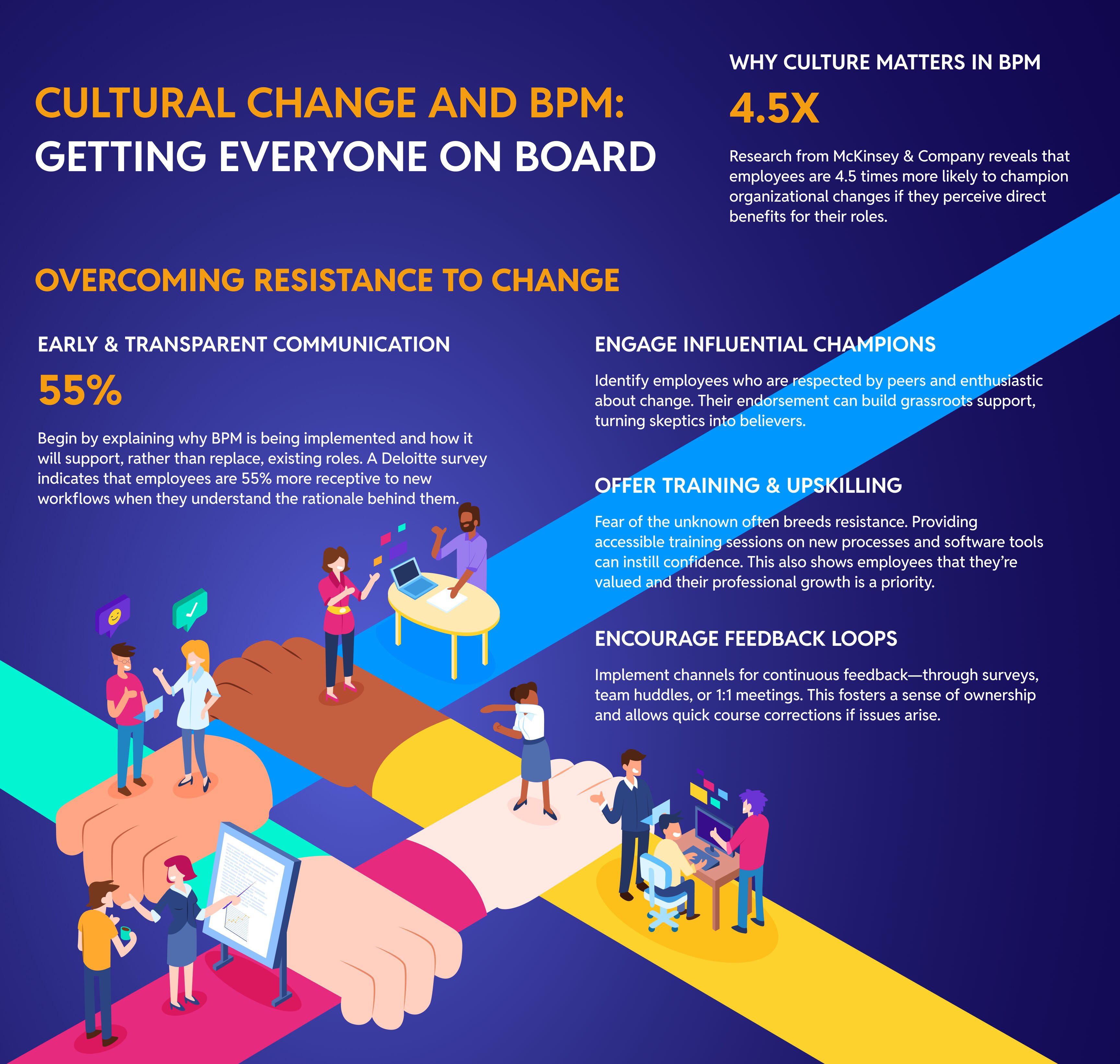Implementing Business Process Management (BPM) goes beyond flowcharts and automation tools—it often demands a cultural shift within an organization. Even the most meticulously designed processes can falter if employees resist or don’t fully grasp the changes. According to a Harvard Business Review study, 70% of all organizational change initiatives fail due to cultural resistance¹. This statistic underscores the importance of addressing not just the what of BPM but the why—and how to bring people on board every step of the way.
In this article, we’ll explore insights into managing cultural change in BPM, overcoming resistance, and fostering a process-oriented mindset across teams. We’ll also illustrate how XMC360 can help streamline this transition, ensuring that newly implemented processes actually become part of everyday operations.


Why Culture Matters in BPM
When BPM initiatives are introduced, employees might fear that automation or reengineering will render their roles less valuable—or worse, obsolete. This anxiety can lead to active or passive resistance, slowing down process improvements. Research from McKinsey & Company reveals that employees are 4.5 times more likely to champion organizational changes if they perceive direct benefits for their roles². Hence, clarifying the positive impact of BPM—such as reduced repetitive tasks and enhanced skill development—can mitigate fears and build support.
Key Cultural Elements:
- Openness to Innovation: Teams that regularly embrace new technologies and methods adapt more smoothly to BPM initiatives.
- Shared Accountability: Process-oriented thinking thrives when accountability is collective, not siloed by department.
- Empathy & Communication: Managers who actively listen to team members and address concerns can significantly reduce resistance.
Overcoming Resistance to Change

Early & Transparent Communication
Begin by explaining why BPM is being implemented and how it will support, rather than replace, existing roles. A Deloitte survey indicates that employees are 55% more receptive to new workflows when they understand the rationale behind them³.

Engage Influential Champions
Identify employees who are respected by peers and enthusiastic about change. Their endorsement can build grassroots support, turning skeptics into believers.

Offer Training & Upskilling
Fear of the unknown often breeds resistance. Providing accessible training sessions on new processes and software tools can instill confidence. This also shows employees that they’re valued and their professional growth is a priority.

Encourage Feedback Loops
Implement channels for continuous feedback—through surveys, team huddles, or 1:1 meetings. This fosters a sense of ownership and allows quick course corrections if issues arise.
Fostering a Process-Oriented Mindset
Moving to a truly process-centric organization means shifting focus from isolated departmental tasks to end-to-end workflow visibility. This mindset helps each employee understand how their contributions fit into larger objectives.
Define & Communicate Process Goals
Spell out clear, measurable targets like reducing cycle time by 20% or cutting costs by 15%. Connecting these goals to day-to-day tasks makes processes feel more relevant.
Reward Collaboration
Recognize teams and individuals who break down silos, share expertise, and collectively improve workflows. Incentives can include bonuses, public recognition, or professional development opportunities.
Promote Continual Learning
Encourage employees to propose small improvements regularly. Research by Gallup shows that workplaces with a continuous improvement culture see a 14% drop in absenteeism⁴, reflecting higher morale and engagement.
How XMC360 Supports Cultural Change in BPM
At XMC360, we acknowledge that technology alone can’t transform organizations—people do. Our platform provides tools that bolster cultural shifts and help teams adopt BPM more willingly:

Unified Platform for Collaboration
XMC360 consolidates tasks, discussions, and performance metrics in one place. This eliminates departmental silos and makes it easier for employees to see the bigger picture of how their tasks influence overall workflow.

Real-Time Analytics & Dashboards
Clear data visualization helps teams monitor progress, celebrate small wins, and identify areas needing improvement. By making successes visible, employees are more motivated to embrace further changes.

Adaptable Training Modules
We offer built-in tutorials and knowledge bases that guide employees through new processes. This just-in-time learning ensures that team members can get help when they need it, reducing frustration and speeding up adoption.

Feedback & Continuous Improvement Loops
XMC360 integrates feedback features—like surveys and comment sections—into process workflows. This embeds collaborative problem-solving into the organizational fabric, promoting a culture of constant refinement.

By leveraging XMC360, businesses can address the human side of BPM, ensuring that employees feel empowered rather than sidelined by new processes.
Cultural change isn’t a footnote in BPM initiatives; it’s the linchpin that determines whether new systems will endure or crumble under resistance. By communicating early and often, engaging influential champions, and offering the training and tools employees need, organizations can cultivate a process-oriented mindset that propels them forward.
XMC360 stands ready to support every step of this journey—from initial planning to real-time collaboration and analytics. When teams feel understood, involved, and trained, BPM becomes more than a project—it becomes part of the organization’s DNA.
References:
- Harvard Business Review. (2020). Leading Through Change: Overcoming Cultural Barriers.
- McKinsey & Company. (2018). The People Factor in Continuous Improvement.
- Deloitte. (2021). Employee Engagement & Organizational Change Study.
- Gallup. (2022). State of the Global Workplace: The Continuous Improvement Edition.


